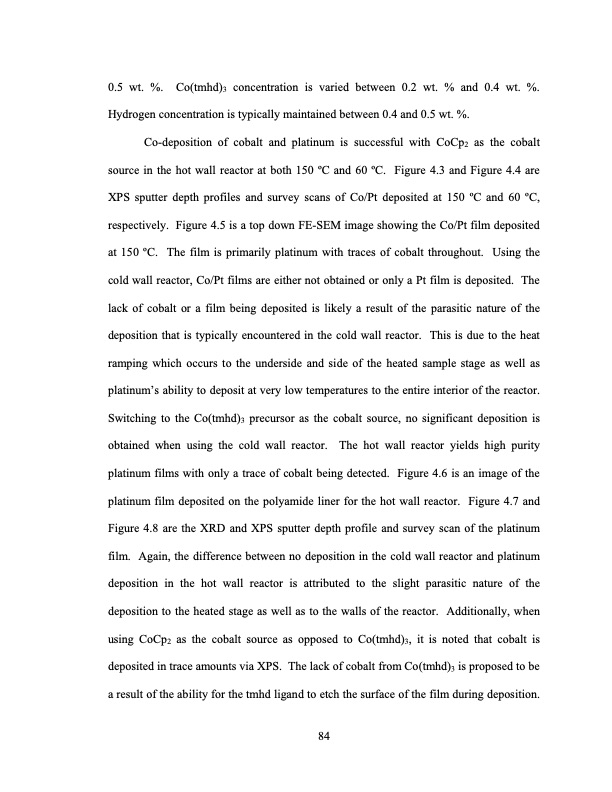
PDF Publication Title:
Text from PDF Page: 108
0.5 wt. %. Co(tmhd)3 concentration is varied between 0.2 wt. % and 0.4 wt. %. Hydrogen concentration is typically maintained between 0.4 and 0.5 wt. %. Co-deposition of cobalt and platinum is successful with CoCp2 as the cobalt source in the hot wall reactor at both 150 oC and 60 oC. Figure 4.3 and Figure 4.4 are XPS sputter depth profiles and survey scans of Co/Pt deposited at 150 oC and 60 oC, respectively. Figure 4.5 is a top down FE-SEM image showing the Co/Pt film deposited at 150 oC. The film is primarily platinum with traces of cobalt throughout. Using the cold wall reactor, Co/Pt films are either not obtained or only a Pt film is deposited. The lack of cobalt or a film being deposited is likely a result of the parasitic nature of the deposition that is typically encountered in the cold wall reactor. This is due to the heat ramping which occurs to the underside and side of the heated sample stage as well as platinum’s ability to deposit at very low temperatures to the entire interior of the reactor. Switching to the Co(tmhd)3 precursor as the cobalt source, no significant deposition is obtained when using the cold wall reactor. The hot wall reactor yields high purity platinum films with only a trace of cobalt being detected. Figure 4.6 is an image of the platinum film deposited on the polyamide liner for the hot wall reactor. Figure 4.7 and Figure 4.8 are the XRD and XPS sputter depth profile and survey scan of the platinum film. Again, the difference between no deposition in the cold wall reactor and platinum deposition in the hot wall reactor is attributed to the slight parasitic nature of the deposition to the heated stage as well as to the walls of the reactor. Additionally, when using CoCp2 as the cobalt source as opposed to Co(tmhd)3, it is noted that cobalt is deposited in trace amounts via XPS. The lack of cobalt from Co(tmhd)3 is proposed to be a result of the ability for the tmhd ligand to etch the surface of the film during deposition. 84PDF Image | Supercritical Fluid Deposition Of Thin Metal Films

PDF Search Title:
Supercritical Fluid Deposition Of Thin Metal FilmsOriginal File Name Searched:
Supercritical-Fluid-Deposition-Of-Thin-Metal-Films-Kinetics-Mec.pdfDIY PDF Search: Google It | Yahoo | Bing
Sulfur Deposition on Carbon Nanofibers using Supercritical CO2 Sulfur Deposition on Carbon Nanofibers using Supercritical CO2. Gamma sulfur also known as mother of pearl sulfur and nacreous sulfur... More Info
CO2 Organic Rankine Cycle Experimenter Platform The supercritical CO2 phase change system is both a heat pump and organic rankine cycle which can be used for those purposes and as a supercritical extractor for advanced subcritical and supercritical extraction technology. Uses include producing nanoparticles, precious metal CO2 extraction, lithium battery recycling, and other applications... More Info
| CONTACT TEL: 608-238-6001 Email: greg@infinityturbine.com | RSS | AMP |